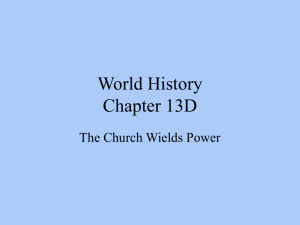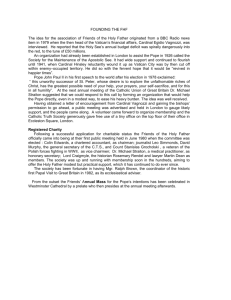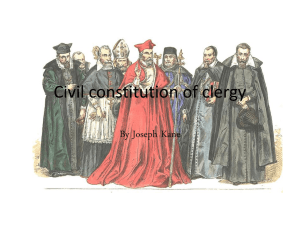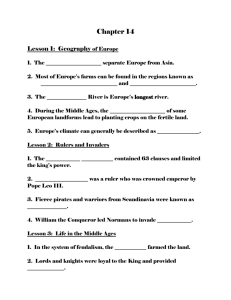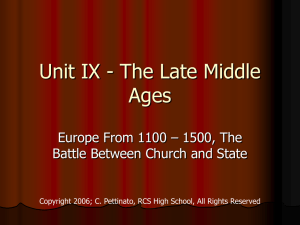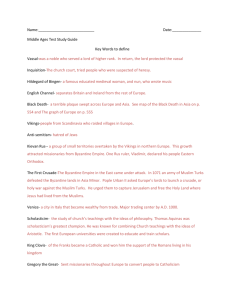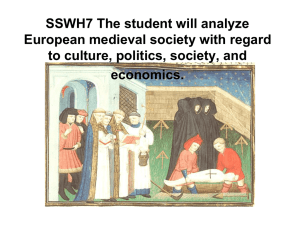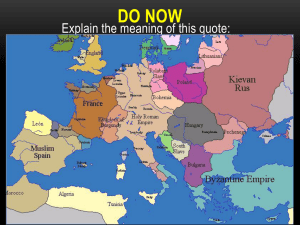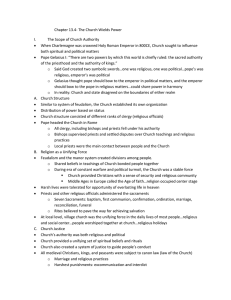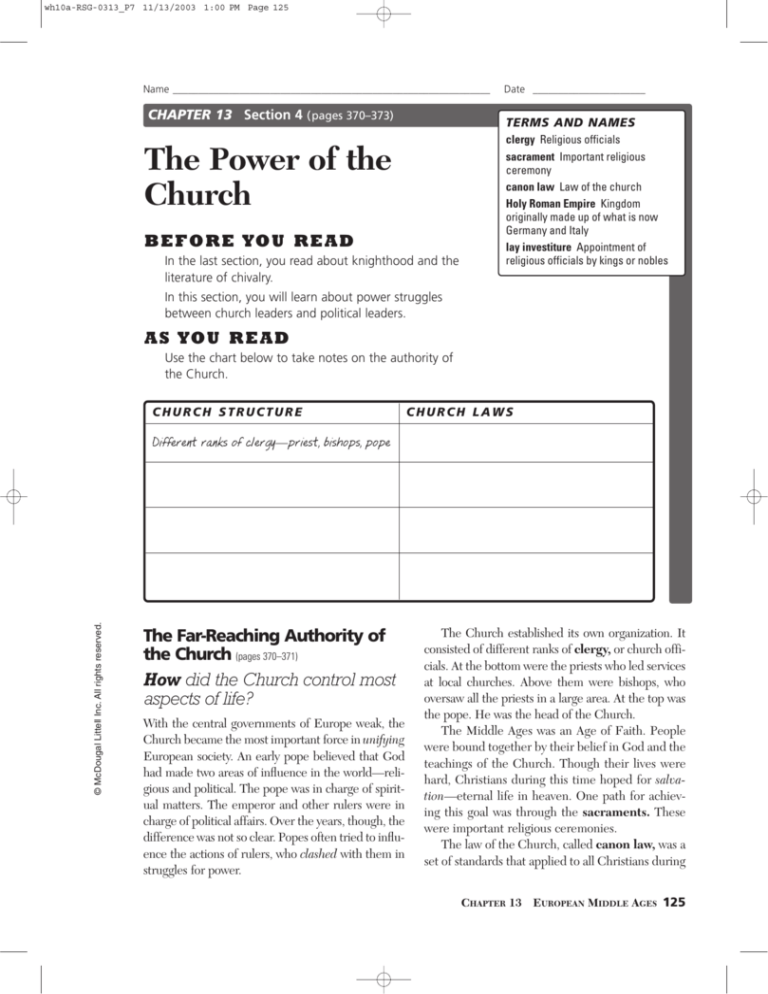
wh10a-RSG-0313_P7 11/13/2003 1:00 PM Page 125
Name ______________________________________________________________
CHAPTER 13 Section 4 (pages 370–373)
The Power of the
Church
BEFORE YOU READ
In the last section, you read about knighthood and the
literature of chivalry.
Date ______________________
TERMS AND NAMES
clergy Religious officials
sacrament Important religious
ceremony
canon law Law of the church
Holy Roman Empire Kingdom
originally made up of what is now
Germany and Italy
lay investiture Appointment of
religious officials by kings or nobles
In this section, you will learn about power struggles
between church leaders and political leaders.
AS YOU READ
Use the chart below to take notes on the authority of
the Church.
CHURCH STRUCTURE
CHURCH LAWS
© McDougal Littell Inc. All rights reserved.
Different ranks of clergy—priest, bishops, pope
The Far-Reaching Authority of
the Church (pages 370–371)
How did the Church control most
aspects of life?
With the central governments of Europe weak, the
Church became the most important force in unifying
European society. An early pope believed that God
had made two areas of influence in the world—religious and political. The pope was in charge of spiritual matters. The emperor and other rulers were in
charge of political affairs. Over the years, though, the
difference was not so clear. Popes often tried to influence the actions of rulers, who clashed with them in
struggles for power.
The Church established its own organization. It
consisted of different ranks of clergy, or church officials. At the bottom were the priests who led services
at local churches. Above them were bishops, who
oversaw all the priests in a large area. At the top was
the pope. He was the head of the Church.
The Middle Ages was an Age of Faith. People
were bound together by their belief in God and the
teachings of the Church. Though their lives were
hard, Christians during this time hoped for salvation—eternal life in heaven. One path for achieving this goal was through the sacraments. These
were important religious ceremonies.
The law of the Church, called canon law, was a
set of standards that applied to all Christians during
CHAPTER 13 EUROPEAN MIDDLE AGES 125
wh10a-RSG-0313_P8 11/13/2003 1:00 PM Page 126
the Middle Ages. These standards guided such matters as marriage and religious practices. The
Church also set up courts. People who broke canon
law were put on trial.
Two punishments were especially harsh. If the
Church excommunicated a person, he or she was
out of the Church forever. The person was denied
the chance for eternal life in heaven. Popes often
used this power to threaten rulers. The other punishment was interdiction. When a ruler disobeyed
the pope, the Church leader could place the land
under interdiction. That meant that no sacred
actions of the Church could officially take place
there. The people of the area deeply feared this.
They might then be doomed to eternal suffering in
hell.
For a long time, rulers had the power to name
the bishops who led the Church in their lands. This
power was known as lay investiture. In 1075,
Pope Gregory VII banned this practice. Henry IV
was angry. He persuaded his bishops to say that this
pope had no real authority. Gregory then excommunicated Henry. Henry’s nobles supported
Gregory. So Henry begged the pope for forgiveness. The pope forgave him.
The larger issue of lay investiture was left open
until 1122. Then an agreement stated that only the
pope could name bishops. However, the emperor
had the right to turn down any appointment he did
not like.
2. Why did Henry IV beg Pope Gregory VII for
forgiveness?
1. What powerful punishments could the Church hand
down?
Disorder in the Empire (page 373)
How did conflict develop between
the pope and the Holy Roman
emperor?
Otto I was the strongest ruler of medieval
Germany. He set up an alliance with the Church.
In 962, the pope crowned him emperor of what
became the Holy Roman Empire.
The Holy Roman Empire was the strongest
kingdom that arose from Charlemagne’s fallen
empire. It was mainly made up of what is now
Germany and Italy. One of Otto’s successors was
Henry IV. He and Pope Gregory VII became
caught in a conflict.
126 CHAPTER 13 SECTION 4
Who was Frederick I?
In the late 1100s, a strong German king came to
power. His name was Frederick I. He repeatedly
invaded the cities of Italy but lost an important battle in 1176. He then made peace with the pope.
When Frederick died in 1190, his empire fell
apart. It was broken up into feudal states. These
German states did not unify during the Middle
Ages.
3. What happened to the Holy Roman Empire after
Frederick I’s death?
© McDougal Littell Inc. All rights reserved.
The Church and the Holy Roman
Empire; The Emperor Clashes
with the Pope (pages 371–372)


